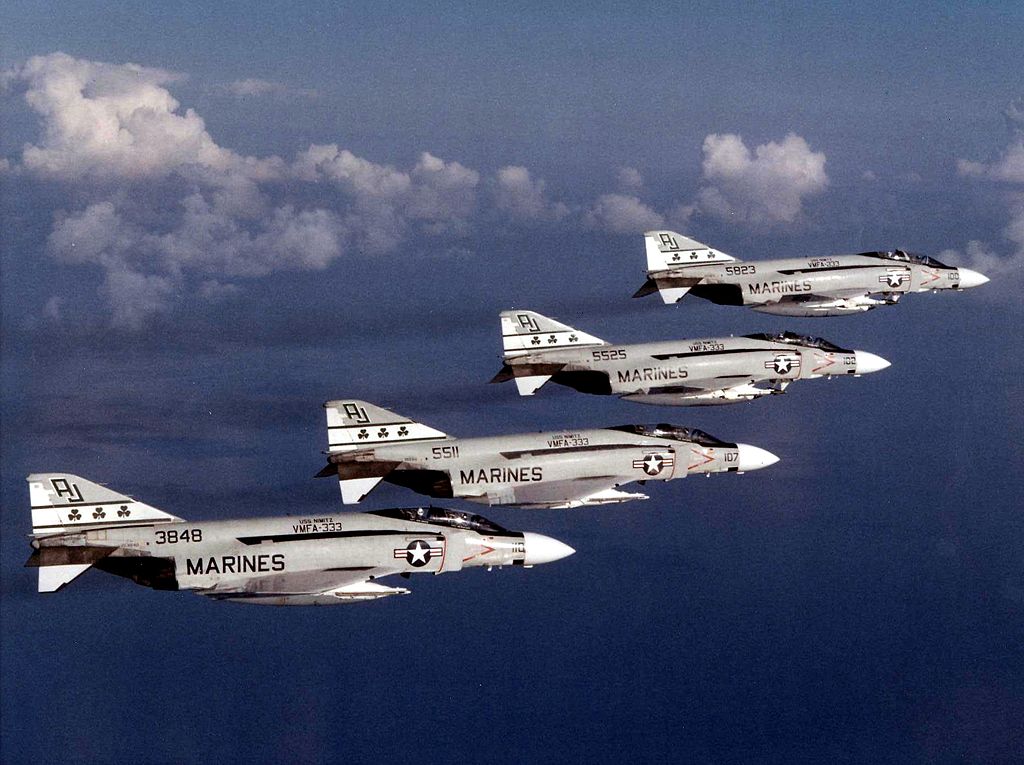With the US Air Force joining the Navy and Marines and realizing the potential of the Phantom’s versatile load-carrying capability and performance, the Phantom possessed the singular distinction of being the first true Joint Strike Fighter
The Mighty F-4 Phantom made its debut flight on May 27, 1958. The Phantom, which was designed to be a carrier-based interceptor, subsequently carried out just about every other mission imaginable, including anti-surface-to-air missile (SAM) Wild Weasel Missions, photo-reconnaissance, dogfighting, and bombing. The US Air Force, which saw the potential of the Phantom’s versatile load-carrying capability and performance, joined the Navy and Marines as the Phantom also held the unique distinction of being the first real Joint Strike Fighter.
The Phantom would initially struggle from being unduly dependent on its all-missile battery and superior technology when operating in the skies over North Vietnam against more agile North Vietnamese Air Force (NVAF) MiG-17s and 21s. Seeing this, the Navy transformed its Fleet Air Gunnery Unit into a new Fighter Weapon School, commonly known as TOPGUN today. There, a new generation of aviators received instruction in traditional air combat maneuvering against various aircraft. The idea of a two-man crew was also perfected, and backseaters became a crucial additional set of eyes both inside and outside the aircraft. According to multiple stories, many Phantom Phlyers owe their backseaters their lives.

Because of this “software” upgrading of its Aviators, the Navy’s Phantom community defeated the NVAF once more in 1972 with a fantastic victory-loss ratio. The Air Force decided on a “hardware” upgrade, giving its most advanced Phantom variant, the F-4E, a 20 mm Vulcan internal gun and improving its missiles and systems. The Combat Tree hostile Identification Friend Foe (IFF) identifier allowed airframes equipped with this system to detect and distinguish Soviet-made IFF systems in the crowded skies of Vietnam, and it proved to be a very important system. This lessened the possibility of “own goals” and made it possible to deploy the Radar Guided Sparrow missile system of the Phantom in a way that enhanced its combat efficiency.
Despite these technical advancements, the Air Force ratio remained around 2-1 compared to the Navy ratio after Rolling Thunder, which was 5-1. With a new generation of aviators being trained by Vietnam-era Phantom Veterans, the USAF’s performance in Desert Storm was much enhanced as a result of the USAF’s post-Vietnam implementation of its Red Flag Adversary Training system.
The Phantom saw action in Israeli hands from 1969’s War of Attrition until 1973’s Yom Kippur War, becoming a significant export success for Israel. The Phantom suffered some of its worst losses during the latter combat when it came up against Soviet-made Surface to Air Missile systems. In spite of this, squadrons changed their tactics as a result of these losses by using what IAF 107 SQD Commander Yftach Spector referred to as “physics” rather than electronics.
By the 1970s, export orders had increased the F-4’s overall production to almost 5,000 units, cementing the Phantom’s status as “The” plane of the Free World. By this time, Phantoms were regularly engaged in combat with Soviet-built MiG-21s over North Vietnam and the Middle East, and Greek and Turkish Phantoms and F-16s were engaged in similar combat over the Aegean Sea, just as both countries still do with their F-16s.
The Islamic Republic of Iran Air Force (IRIAF) was able to hold the line against Saddam Hussein’s invasion of Iran in 1980 because of its Phantom force, which would go on to become the backbone of the Iranian Air Force both before and after the Shah. Iran’s Phantom force, although having a decreasing number of airframes and spares that were irregularly filled up by both legal and illegal means, maintained roughly parity with Iraq’s Air Force until the end of the fight by employing hard-learned Vietnam and Israeli tactics. Iran still uses the Phantom today, both out of necessity and because of the tremendous might it offers.
The Phantom is still in use in a decreasing number of Air Forces across the world after flying its twilight combat missions in US Service during Desert Storm. For those who had the good fortune to grow up on the island of Oahu, where the final Active-Duty USMC Phantom squadrons and the Hawaii Air National Guard’s 199th Fighter Squadron operated the F-4, the Phantom’s J79s roar might ring like an echo of the Vietnam War.
This song is dedicated to everyone who has ever flown the Phantom, front or back.
Check out the Pensacola Aerospace Museum Facebook page for further aviation photos and stories.
Photo by: U.S. Air Force, U.S. Navy and U.S. Marine Corps

